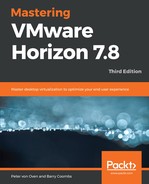The next task is to configure the connection between View Administrator and vCenter Server:
- From the View Administrator main screen, expand the View Configuration option (1), and then select Servers (2). Next, from the Servers screen, ensure that the vCenter Servers tab is selected (3), and then click the Add… button (4), as shown in the following screenshot:

- You will now see the vCenter Server Information screen shown in the following screenshot:

- In the Server address box (5), type in the address of the vCenter Server you want to connect to the Connection Server. In the example lab, this is vcs2.pvolab.com, the address of the vCenter managing the virtual desktops.
- Next, in the User name box (6), type in the vCenter username followed by the password for this account in the Password box (7). In this example, the administrator account has been used; however, you will probably want to use the specific user account for this that we created earlier in this chapter.
- You will now see the following Invalid Certificate Detected warning box:

- Click the View Certificate… button (8). You will now see the Certificate Information box.
- Click the Accept button.
- The next screen is the View Composer Settings screen shown in the following screenshot:

- You have three options to configure View Composer: Do not use View Composer, View Composer co-installed with vCenter Server, and Standalone View Composer Server.
- For the example lab, View Composer is going to be installed on a standalone server, so click the Standalone View Composer Server radio button (10).
- Next, you need to enter the details of the View Composer Server. In the Server address box (11), type in the server address. In the example lab, this is vcs2.pvolab.com. Then, type in the username for this server in the User name box (12). Remember to add this in the format domainusername, so in the example lab, type pvolabadministrator followed by the password for this user account in the Password box (13). Leave the Port box (14) at the default setting of 18443.
- When you have completed the details, click the Next > button.
- As with adding the vCenter Server, you will again see the following Invalid Certificate Detected warning box:

- Click the View Certificate... button (15). You will now see the Certificate Information box
- Click the Accept button. You will now see the View Composer Domains configuration screen shown in the following screenshot:

- On this screen, we are going to configure View Composer with access to a domain account to allow it to add, create, and delete computer accounts in AD. Click the Add… button (17). You will now see the Add Domain configuration box shown in the following screenshot:

- In the Full domain name box (18), type in the domain name. In the example lab, this is pvolab.com. Then, in the User name box (19), enter the username that has the ability to create and delete computer objects in AD. In the example lab, we will use the administrator account.
- Finally, in the Password box, type in the password for the administrator account. Click the OK button when you have entered the information. You will now return to the View Composer Domains configuration screen, which now shows the configured domain details, entered as shown in the following screenshot:

- Click the Next > button to continue.
- You will now see the Storage Settings configuration screen. There are two main elements to configure here. The first option is to configure whether or not you want to Reclaim VM disk space for your virtual desktops. If this is selected, the virtual machines will be configured with space-efficient disks, which will allow the reclamation of unused space.
- The second option is to configure Enable View Storage Accelerator. This allows a specific amount of memory to be utilized as a read cache to reduce the storage overheads on the shared or local storage used to run the VMs. By default, this will be set to 1024 MB of memory per server and can be increased to up to 2GB per server. Alternatively, if you check the box for Show all hosts, you can then select individual host servers and configure the cache size differently on each host server.
- In the example lab, we are going to enable the options for Reclaim VM disk space and Enable View Storage Accelerator, as shown in the following screenshot:

- Click the Next > button to continue. You will now see the Ready to Complete screen shown in the following screenshot:

- Finally, check the configuration details and then click the Finish button to complete the configuration. You will return to the View Administrator screen, which now shows the vCenter Server that was just added, as shown in the following screenshot:

View Administrator screen
You have now added a vCenter Server to Horizon View. In the next section, we are going to configure the View events database.
